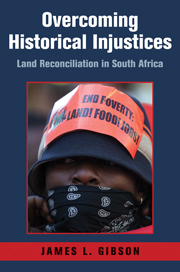Book contents
- Frontmatter
- Contents
- List of Figures
- List of Tables
- Preface and Acknowledgments
- 1 Land Reconciliation and Theories of Justice, Past and Present
- 2 Naming, Blaming, and Claiming on Historical Land Injustices: The Views of the South African People
- 3 Group Identities and Land Policy Preferences
- 4 Applied Justice Judgments: The Problem of Squatting
- 5 Judging the Past: Historical versus Contemporary Claims to Land
- 6 Land Reconciliation and Theories of Justice
- Appendix A A Note on Race in South Africa
- Appendix B The Survey Methodology
- Appendix C The Questionnaire
- References
- Index
- CAMBRIDGE STUDIES IN PUBLIC OPINION AND POLITICAL PSYCHOLOGY
Appendix A - A Note on Race in South Africa
Published online by Cambridge University Press: 27 July 2009
- Frontmatter
- Contents
- List of Figures
- List of Tables
- Preface and Acknowledgments
- 1 Land Reconciliation and Theories of Justice, Past and Present
- 2 Naming, Blaming, and Claiming on Historical Land Injustices: The Views of the South African People
- 3 Group Identities and Land Policy Preferences
- 4 Applied Justice Judgments: The Problem of Squatting
- 5 Judging the Past: Historical versus Contemporary Claims to Land
- 6 Land Reconciliation and Theories of Justice
- Appendix A A Note on Race in South Africa
- Appendix B The Survey Methodology
- Appendix C The Questionnaire
- References
- Index
- CAMBRIDGE STUDIES IN PUBLIC OPINION AND POLITICAL PSYCHOLOGY
Summary
It is common in South Africa to divide the total population into four racial categories for the purposes of research or the explanation of demographic realities and/or socio-economic conditions in the country, and I follow this practice throughout the analysis reported in this book. As James and Lever (2000, 44) note: “The use of these categories is unavoidable given the fixity that they have come to acquire both in popular consciousness and official business.” The use of these racial terminologies, however, differs from the way racial categorization may be understood in other societies. It is therefore important to understand the historical development of these categories, especially the legal boundaries imposed on racial groups by the apartheid government.
The four racial groups are African, white, Coloured, and South Africans of Asian origin (Indian). These groups are also often referred to as population groups, ethnic groups (although this term usually refers to African subcategories such as Xhosa or Zulu), or national groups. The African majority has been known by European settlers by different names over time, such as “native,” “Bantu,” or “Black,” and some of these terminologies were later formalized by apartheid legislation. The Africans were the original inhabitants of the area now called South Africa and were descendants of Iron Age farmers speaking different variants of Bantu languages, spoken in sub-Saharan Africa, east of Cameroon (James and Lever2000, 44). Generally, I refer to these people as Africans or blacks.
- Type
- Chapter
- Information
- Overcoming Historical InjusticesLand Reconciliation in South Africa, pp. 219 - 220Publisher: Cambridge University PressPrint publication year: 2009



